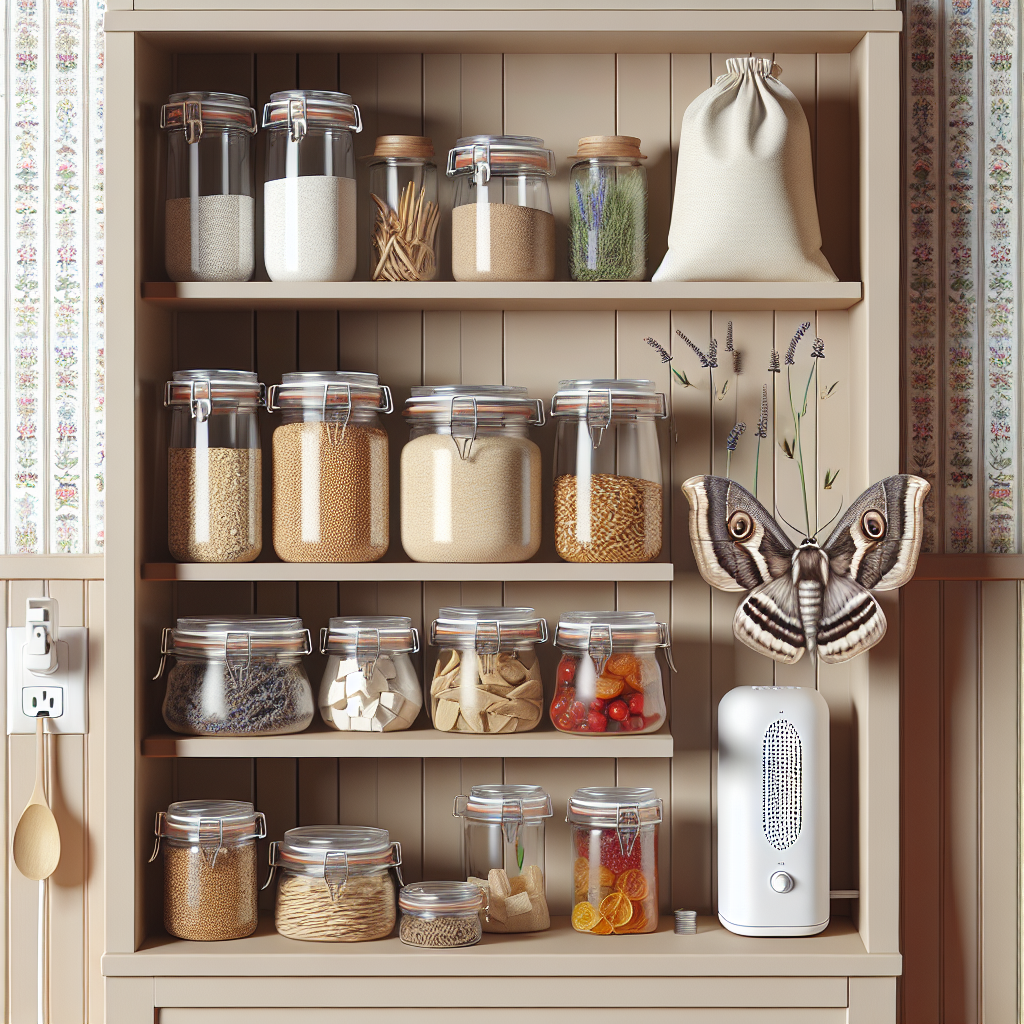How to Keep Moths Away from Pantry Items
Updated April 30, 2024 at 2:59 pm
Discover practical strategies to protect your pantry from pesky moths, ensuring your staples remain fresh and uncontaminated. This guide offers easy-to-follow tips for moth-proofing your storage areas.

“`html
Understanding Pantry Moth Infestations
Discovering moths fluttering around your pantry can be distressing, not to mention the potential waste of food and money they bring. These pesky insects, particularly the Indian meal moth, are notorious for invading and laying eggs in your dry goods.
Identifying the Culprit
Before tackling the issue, it’s essential to determine the presence of pantry moths. Look out for adult moths, larvae, silken webs, or clumps in food which indicate contamination. Pet Friendly, pantry moths pose no direct threat to pets. Light Requirements, moths are nocturnal and drawn to dimly-lit areas. Watering, ensure pantry items are dry to avoid attracting moths. Humidity, lower levels can discourage moth activity. Temperature, average room temperature environments are often ideal for moths. Difficulty, dealing with an infestation can be challenging but manageable with persistence.
Removing Infested Items
The first step towards a moth-free pantry is to eliminate infested items. Check all food packages, paying special attention to grains, flours, nuts, and similar items for any signs of infestation.
Cleaning Your Pantry Thoroughly
Once affected products are discarded, a thorough cleaning of the pantry is necessary. Wipe down all surfaces with a vinegar solution to kill lingering eggs and larvae, paying attention to crevices and shelves where insects could hide or lay eggs.
Maintaining Cleanliness
Preventing a re-infestation requires maintaining cleanliness. Regularly cleanse pantry surfaces and keep dry goods in sealed containers to deny access to moths.
Creative Storage Solutions
Investing in airtight containers like those from OXO Good Grips can safeguard your food from pests. These containers have received praise for their durability and effective seal, making them an essential addition to any pantry.
Find This and More on Amazon
Natural Repellents: The Power of Herbs
Various herbs and essential oils act as natural deterrents for pantry moths. Placing sachets filled with bay leaves, lavender, or peppermint in your pantry could help keep these insects at bay.
DIY Pantry Moth Traps
A simple yet effective solution for capturing adult moths are homemade traps. By combining a sticky substance with a pheromone or sweet lure, you can trap moths before they reproduce.
Professional-Grade Moth Traps
If DIY isn’t your thing, consider commercial pheromone traps like Dr. Killigan’s Pantry Moth Traps. These traps advertise a non-toxic approach that appeals to environmentally conscious users. Reviewers commend their effectiveness in attracting and trapping pantry moths without hazardous chemicals.
Find This and More on Amazon
Long-Term Strategies
For lasting results, rotate pantry items regularly and inspect new groceries before adding them to your pantry. This proactive approach minimizes the chances of inadvertently introducing moths to your pantry.
Professional Pest Control
Should the problem persist, enlisting the help of professional pest control services may be the best course of action. Experts can offer tailored solutions and preventive measures to ensure moths don’t return.
Preventative Measures for Future Protection
Taking steps to prevent moth infestations can save time and money in the long run. Sealing cracks, proper food storage, and regular inspections are critical preventative measures to implement.
Moth-Proofing with Bay Leaves
Incorporating bay leaves into your pantry design can serve as both a natural deterrent and a visually appealing element. Tuck these aromatic leaves into your storage containers to confound and repel moths.
Community Wisdom: Sharing Tips and Tricks
Exchanging tips with peers can reveal novel solutions. It’s said that individuals recommend freezing susceptible items like flour and grains to kill any existing larvae or eggs.
Learning from Experience: Troubleshooting Common Issues
Understanding common missteps, such as neglecting to check grocery bags for lurking pests, can empower you to manage and prevent future occurrences more effectively.
The Key Role of Consistency
Consistently applying these guidelines is crucial. Ingraining habits such as stocking goods properly and routinely cleaning can safeguard your pantry from future invasions.
Revisiting Your Strategy: Adapting to New Challenges
If moths continue to be a problem, revisiting and adapting your prevention strategy is advisable. The use of tight-sealing containers, routine cleaning, and the inclusion of natural repellents should be regularly assessed for their effectiveness.
“““html
Expert Advice on Sealing Containers and Pantry Design
Having a well-organized pantry is not just about aesthetics, it plays a crucial role in preventing moth infestations. Experts suggest using clear, sealed containers to store grains and other dry goods. This allows for easy monitoring of food stocks and ensures that any potential contamination can be quickly identified and dealt with. Brands like Rubbermaid Brilliance offer crystal-clear containers with airtight seals that are perfect for this purpose.
According to reviews, Rubbermaid Brilliance containers are favored for their secure stacking capability which maximizes space efficiency — a key feature for maintaining an organized pantry. The leak-proof design also makes them versatile for both dry and wet foods.
Find This and More on Amazon
Deterrents That Blend into Your Home Decor
Who says moth repellents can’t be decorative? There are many solutions that combine form and function. For instance, consider decorative glass jars with secure lids that can store herbs and spices while acting as a moth deterrent. Herbs like mint, which moths dislike, can be displayed and function as a repellent.
Finding The Best Moth Repellents
When looking for moth repellents, it’s important to select those which are nontoxic and safe for use in food storage areas. Essential oil diffusers using oils like cedarwood or clove can discourage moths and provide a pleasant aroma. There are also cedar blocks and rings that can be placed amongst your pantry items for a natural, chemical-free moth deterrent.
Education on Pantry Moth Life Cycle and Habits
To effectively control pantry moths, it’s beneficial to understand their life cycle and habits. These pests go through a complete metamorphosis, starting as eggs, which hatch into larvae that feed on your dry goods. Eventually, they change into pupae and then mature into adult moths. Knowing this cycle can help you target your efforts during their most vulnerable stages.
Myth Busting: What Doesn’t Work Against Pantry Moths
Amidst helpful tips, some myths simply don’t hold up against pantry moths. For example, placing a cedar block alone in your pantry might not be enough since its efficacy fades over time and it doesn’t affect eggs or larvae. It’s important to supplement any single method with a combination of other strategies for an effective defense.
Combining Tactics for a Comprehensive Approach
For maximum protection against pantry moths, a multi-pronged approach should be adopted. This includes regular cleaning, using sealed containers, employing natural repellents, monitoring with traps, and maintaining vigilance in grocery shopping and storage.
What To Do If You Find Moths in New Purchases
In case you encounter moths or larvae in new grocery items, immediate action is necessary. Place the infested items in a sealed bag and dispose of them outside your home to prevent spreading. Then, clean the area where the contaminated item was stored to remove any residual larvae or eggs.
Techniques for Disposing of Infested Foods
If you have to dispose of infested foods, ensure that you do so in a sealed bag or container to prevent any potential spread within your trash or compost. In some cases, you might be able to salvage unaffected parts of the food by freezing or heating it to kill any hidden pests.
The Role of Freezing and Heating in Moth Control
Some homeowners rely on freezing susceptible items to kill any hidden eggs or larvae. Storing grains, nuts, and dried fruit in the freezer for a few days upon bringing them home can be an effective preventive measure. Likewise, heating these items in an oven can also serve to eliminate any moth stages.
Incorporating Technology with Moth Prevention
Advances in home technology provide new ways to combat pests. Smart containers with sensors for opening and closing, and temperature or humidity monitoring can help preserve your pantry items in optimal conditions and reduce the risk of pest infestations.
Tackling the Root of the Problem: Preventing Moth Entry
A crucial step in moth prevention is ensuring that moths don't enter your home in the first place. Inspect all screens, doors, and windows for gaps where insects could enter, and consider adding door sweeps or screen patches as necessary.
Endurance and Patience: The Long Battle Against Pantry Moths
Finally, managing a pantry moth infestation is not an overnight battle. It often requires consistent effort over several weeks to months. Perseverance and regular maintenance of the strategies mentioned can ultimately lead to a moth-free pantry and home.
“““html
Embracing Organic Solutions for Moth Repellent
Embracing organic solutions can be a safe and environmentally friendly way to deter pantry moths. Diatomaceous earth, for instance, is a non-toxic powder that can be sprinkled in and around the pantry to eliminate moths without harming humans or pets.
Aside from being a desiccant that kills insects, Diatomaceous earth has gained positive mentions from users for its ease of use and effectiveness. Just remember to choose the food-grade version for pantry applications.
Leveraging Light to Your Advantage
Moths are typically repelled by bright light, so making your pantry brighter might discourage them from entering. Consider using LED light strips to make every corner of your pantry less inviting to moths. Upgrading your pantry lighting not only helps with pest control but also enhances visibility for better food management.
LED lights are a favorite among homeowners due to their energy efficiency and longevity, thus providing an added benefit of lower utility bills over time.
Understanding the Role of Pesticides in Moth Control
While pesticides can play a role in moth control, they should be used cautiously, especially around food. If you choose to use them, go for options that are specifically designed for food storage areas and follow the instructions meticulously to avoid contamination.
There are products with natural active ingredients that are safer for indoor use around food items. Despite their lower toxicity, they require careful application and may need to be part of a broader integrated pest management strategy.
Building a Routine to Keep Moths at Bay
Developing a consistent routine is key to keeping your pantry moth-free. This includes regular inspections of your pantry stock, promptly wiping up any spills, and rotating your dry goods to ensure older items are used first. These practices contribute to maintaining a clean and organized food storage area.
The combination of good pantry hygiene and strategic prevention measures can significantly reduce the likelihood of a moth infestation taking hold in your home.
Beneficial Pantry Organizational Tools
Organizational tools can go a long way in keeping pantry moths away. Consider label makers to clearly mark your containers with content descriptions and dates, which can help you keep track of inventory and ensure nothing gets too old. This might seem like a small step, but being meticulous can be a crucial preventative measure.
Many people find such methodical organization aids not only in pest management but also in making meal prep simpler and more efficient.
Sharing Your Moth Prevention Journey with Others
After you’ve had success in keeping moths out of your pantry, sharing your journey with friends and family can be helpful. Everyone benefits from shared experiences, and you might pick up additional tips along the way.
You can also contribute to online communities and social media groups dedicated to home organization and pest control strategies, further expanding your knowledge and helping others.
Investing in Quality Pantry Remodeling to Prevent Moths
If you’re facing recurring problems with pantry moths, it could be time to consider remodeling your pantry. Modern pantry designs often incorporate elements that deter pests, like tight-fitting drawers and doors, and easily cleanable surfaces.
Though it might be a more significant investment upfront, remodeling your pantry can lead to better pest control, more efficient food storage, and an overall enhancement of your kitchen’s look and functionality.
Custom Solutions for Unique Pantry Setups
Not all pantries are created equal, and sometimes, a custom solution may be necessary. This can mean building or buying custom-sized containers for irregular shelves, using special liners that repel moths, or installing unique lighting fixtures.
Custom solutions ensure that all aspects of your pantry are catered to your needs and can be especially effective in preventing moth infiltrations in hard-to-reach areas.
Final Thoughts: The Importance of Staying Proactive
The battle against pantry moths is ongoing and requires a proactive mindset. By consistently applying the tips and strategies mentioned, and staying vigilant, you can keep these pesky invaders out of your pantry. Remember, early detection and immediate action are vital for effective control and prevention of infestations.
By incorporating these methods into your daily routine and pantry setup, you empower yourself to maintain a clean, organized, and moth-free kitchen, ensuring the safety and longevity of your groceries.
“`
Shop more on Amazon
Flowers & Plants Team
Flowers & Plants Team


